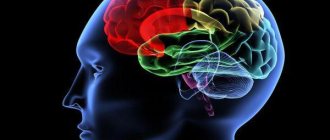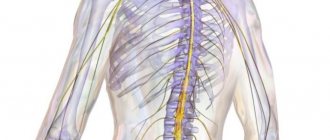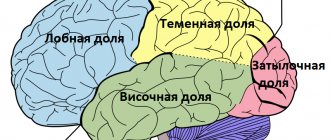Hypothalamic-pituitary dysfunction The basis of a woman’s reproductive system is an interconnected chain of neuroendocrine organs - the hypothalamus - pituitary gland - ovary, the correct functioning of which ensures the maturation of a full-fledged egg, changes in the structure of the endometrium necessary for normal implantation of the embryo, the correct functioning of the epithelium of the fallopian tubes to promote the fertilized egg into the uterus, implantation and maintenance of early pregnancy.
The highest organ of regulation of the hypothalamic-pituitary-ovarian system is the central nervous system, which through a whole complex of direct and reverse interactions ensures the stable operation of the reproductive system.
The hypothalamus (brain structure) is the center of regulation of the menstrual cycle. With the help of releasing hormones, the hypothalamus controls the functioning of the underlying gland, the pituitary gland. The pituitary gland, in turn, regulates the functioning of all endocrine glands - it produces follicle-stimulating hormone (FSH), luteinizing hormone (LH), thyroid-stimulating hormone (TSH). Under the influence of pituitary hormones (FSH, LH and prolactin), cyclic changes occur in the ovaries: egg maturation and ovulation. With most hypothalamic-pituitary diseases, women develop menstrual dysfunction until the cessation of menstruation.
Hypothalamic dysfunctions
This is a set of symptoms that appear as a result of disruption of the metabolic and nutritional processes of the body, the menstrual cycle, and improper functioning of the cardiovascular and nervous systems. The clinical picture of hypothalamic-pituitary dysfunction is:
| Stably increased or decreased body temperature. | Sometimes the indicators can be zigzag. |
| Changes in sleep and wakefulness states. | Increased drowsiness or lack of sleep. Changes in the biological rhythm of the body. Wakefulness is at night, sleep is during the day. |
| Disturbances in the functioning of the heart, lungs, and gastrointestinal tract due to autonomic dysfunction of the nervous system. | Vegetative crises, increased sweating. |
| Changes in metabolism in the body: | excess body weight, or exhaustion. |
| Sexual dysfunctions: | acceleration, release of colostrum from the mammary glands, not caused by feeding. Uncontrolled sexual behavior. |
| Psycho-emotional state disorders: | rage, fear, apathy, anxiety, depression. |
Autonomic dysfunction is manifested by the following characteristic symptoms:
- The heart rhythm changes.
- Frequent changes in blood pressure.
- Disorders of blood circulation in the vessels. The result is pallor, cyanosis, or excessive redness of the skin. Hot flashes and a feeling of heat, or vice versa, chilliness in the body, cold extremities.
- Pain in the heart area of various types, which is not affected by physical activity, and which does not go away after taking validol or nitroglycerin.
- Changes in breathing: lack of air, feeling of insufficient inhalation, respiratory arrest. This dysfunction often causes headaches and conditions that precede loss of consciousness. Often, due to hypoxia, a person feels a state of loss of reality of what is happening.
- Changes in motility of the esophagus, stomach, intestines. They manifest themselves as pain in these organs, belching of air, vomiting, heaviness and bloating in the abdomen.
- Sweating disorders. Excessive sweat production, especially on the inner surfaces of the extremities.
- Sexual dysfunction. Men experience problems with erection and ejaculation, women experience vaginismus and anorgasmia.
- Paroxysms of the vegetative-vascular system. They arise due to disruption of the autonomic system. Can be:
- sympathetic-adrenal crisis. Headache, palpitations, numbness and a feeling of coldness in the extremities occur. Blood pressure rises sharply, physical activity, fear, and agitation appear.
- vagoinsular crisis. Feeling of heat in the face and head, suffocation, stomach pain, slow heart rate. Dizziness, intense sweating. Inhalation of air is difficult. Allergic manifestations such as urticaria or swelling of the throat mucosa are possible.
- mixed crisis. Combines the symptoms of the previous two.
Hypothalamic dysfunctions have a long course with subsequent transition to a chronic form of the disorder. They are characterized by periods of exacerbation.
Eating disorder
The hypothalamus takes part in the regulation of appetite: the ventrolateral nucleus of the hypothalamus is responsible for a person’s feeling of hunger, and the ventromedial nucleus is responsible for the feeling of satiety.
When the lateral nucleus is destroyed, there is a loss of hunger and a complete refusal of food. And irritation of this nucleus, on the contrary, leads to increased food consumption.
Destruction of the medial nucleus leads to uncontrolled consumption of food in large quantities and lack of feeling of satiety. Irritation of the medial nucleus leads to loss of hunger.
Pathology of the ventromedial nucleus causes hypothalamic obesity. The hypothalamus controls body weight.
Its damage leads to its shift, and until the set point reaches a new location, body weight rapidly gains, this is due to the rapid emptying of the stomach and lack of a feeling of satiety.
As the point is established, the person begins to consume food less frequently and in smaller portions.
Violation of thermoregulation
Neurons of the anterior hypothalamus are responsible for the perception of heat and cold, changes in body temperature and the environment. The posterior hypothalamus is responsible for the function of heat transfer.
The hormone prostaglandin, controlled by the pituitary gland, shifts the set point of body temperature upward, which helps to conserve heat and increase heat production in the body until the set point in the hypothalamus takes a new position.
Diseases of the hypothalamus lead to temperature disturbances, against the background of which hypothalamic syndrome develops with impaired thermoregulation.
It is characterized by prolonged subfebrile body temperature, with periodic sharp jumps up to 40 degrees.
Violation of thermoregulation entails vegetative-vascular crises.
Signs indicating a violation of heat exchange in the body are: constant chills, sudden changes in temperature during the day, increased sweating.
Sexual development
If the hypothalamus is damaged, premature sexual development may occur due to impaired secretion of sex hormones. The hypothalamus produces gonadotropin releasing hormone.
Its hypersecretion entails an increase in the level of production of luteinizing and follicle-stimulating hormones of the pituitary gland.
They, in turn, stimulate hypersecretion of sex hormones, thus leading to the premature development of secondary sexual characteristics.
Autonomic epilepsy
Characterized by severe attacks of epilepsy, behavioral and cognitive disorders. Vivid symptoms of manifestation are:
- Unmotivated laughter or crying. The attacks are short and daily.
- Impaired consciousness
- Tonic-clonic seizures (muscle cramps, eye tics, etc.).
Emotional disorders
The hypothalamus takes part in the regulation of the endocrine and autonomic systems, controls the process of formation of emotions.
In diseases of the hypothalamus, the production of hormones by these systems is disrupted, which leads to either hormonal surges or a lack of hormones in the body. Against this background, neuropsychic abnormalities may occur, manifesting themselves in the form of syndromes.
- Neurotrophic syndrome. The skin becomes dry and thinner. Ulcers, bedsores, inflammatory formations, and swelling appear. Body weight is significantly reduced, sometimes to the point of dystrophy. Changes occur in the skeletal system - osteoporosis, sclerosis. The mucous layer of internal organs and body systems becomes thinner, which leads to the formation of ulcers and bleeding.
- Neuroendocrine disorders. It manifests itself in the form of metabolic disorders in the body, dysfunction of the gonads, and diabetes insipidus. It is characterized by vegetative crises.
- Gelastic attacks. These are attacks of epilepsy that manifest themselves as sudden, episodic episodes of uncontrollable laughter that does not bring feelings of joy.
Connection between the pituitary gland and the hypothalamus
The work of the pituitary gland is regulated by the hypothalamus through nerve connections and the blood vessel system. The blood that enters the anterior pituitary gland passes through the hypothalamus and is enriched with neurohormones. Neurohormones are substances of peptide nature that represent parts of protein molecules. They stimulate or, conversely, inhibit the production of hormones in the pituitary gland.
The function of the endocrine system is carried out according to the feedback principle. The pituitary gland and hypothalamus analyze signals coming from the endocrine glands. An excess of hormones from a particular gland inhibits the production of a specific pituitary hormone responsible for the functioning of this gland, and a deficiency prompts the pituitary gland to increase the production of this hormone.
A similar mechanism of interaction between the hypothalamus, pituitary gland and peripheral endocrine glands was worked out by evolutionary development. However, if there is a failure in at least one link of a complex chain, a violation of quantitative and qualitative relationships occurs, entailing the development of endocrine diseases.
Hypothalamic syndrome
This is a combination of endocrine, autonomic, metabolic and trophic functions of the body due to damage to the hypothalamus.
The clinical picture of the disease is especially pronounced during periods of hormonal changes in the body: adolescence, menopausal changes.
Hypothalamic syndrome of puberty (adolescence) is the most common disease among adolescents.
Juvenile hypothalamic syndrome is characterized by a number of clinical symptoms. The most common of them:
| Violation of thermoregulation in children, |
| Deviations in mental development: anxiety, fear, insomnia. |
| The occurrence of a hypothalamic crisis. |
| Violation of fat metabolism. The so-called hypothalamic obesity. |
| Disorders of puberty, the menstrual cycle, the occurrence of polycystic ovary syndrome, premature appearance of secondary sexual characteristics in adolescents. |
Disturbance of the pituitary-hypothalamic structures is characterized by a triad of clinical manifestations confirming the diagnosis of the disease:
- Obesity with the appearance of pink stretch marks on the skin.
- Excessive skeletal growth.
- Autonomic disorders.
Circulatory failure and metabolic disorders due to neurodystrophic syndrome can lead to irritation (irritation) of the cortex and deep structures of the brain.
Signs of irritation:
- Disorders of perception and processing of information,
- Disorientation in time and space,
- Depersonalization is the perception of one’s own actions from the outside.
- Diseases of the endocrine and reproductive systems.
Elimination of symptoms occurs by eliminating the disease that caused the irritation and undergoing psychological techniques to rebuild the structures of the brain.
Possible causes of violations
Dysfunction affecting the mid-stem structures is a brain pathology that is polyetiological in nature, which means there are many possible causes. Factors such as traumatic brain injury, concussion, and ischemic tissue changes can influence the development of brain stem dysfunction. Other factors that increase the likelihood of developing moderate or severe dysfunction of the midline structures of the brain:
- Intoxication.
- Infectious diseases.
- Living in a region with unfavorable ecology.
- Ionizing radiation.
- Cerebrovascular accident.
- Hormonal imbalance.
- Oncological diseases.
If the pathology is diagnosed in a newborn child, the causes may be associated with diseases suffered by the mother, hereditary factors, birth injuries, and oxygen deprivation of the fetus.
Location in the brain
Now let's discuss where exactly these structures are located in the brain - the pituitary gland, hypothalamus, pineal gland. The pituitary gland is located at the base of the brain, down in a bony pocket called the sella turcica. It is located close to the spinal cord. Through its ducts, all substances produced by the hypothalamic-pituitary system enter the body.
Hypothalamus - hypothalamus, from Greek. department or room. It is part of the intermediate section of the brain and is the main regulator of nervous processes. It is located under the optic thalamus, behind the midbrain.
Hypothalamic-pituitary insufficiency
This pathology is characterized by a decrease in the level of hypothalamic hormones, leading to hypomenstrual and hypermenstrual (less commonly) syndrome - scanty or heavy menstruation.
In women with hypothalamic-pituitary insufficiency, the uterus is reduced, the cervix has a conical shape, the tubes are elongated, thin, tortuous, and the vagina is narrow. This pathological condition is called sexual infantilism. Such anatomical features of the genital organs play a certain role in the occurrence of infertility, but the absence of ovulation is of primary importance.
Treatment of endocrine infertility is carried out depending on the nature and location of the pathological process.
For hypothalamic-pituitary insufficiency and infantilism, hormone therapy is used. Treatment should be carried out strictly as prescribed by a gynecologist under regular monitoring of the amount of sex hormones (estrogen) in the blood and urine.
Adenohypophysis and neurohypophysis
The pituitary gland consists of 3 lobes. Anterior - adenohypophysis, posterior and middle. The middle lobe is mostly located in the peduncle emanating from the hypothalamus. The adenohypophysis is the largest part of the pituitary gland, contains most of its mass and performs most of its functions.
The posterior lobe of the pituitary gland is called the neurohypophysis. This part is located behind the adenohypophysis and performs secretory and storage functions. This department maintains the tone of small vessels, the tone of the uterus during childbirth and regulates water-salt balance.









